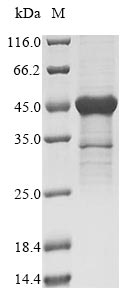Amino acids 2-243 constitute the expression domain of recombinant Human RPS3. The expected molecular weight for the RPS3 protein is calculated to be 42.6 kDa. This RPS3 recombinant protein is manufactured in e.coli. The RPS3 coding gene included the N-terminal 6xHis-SUMO tag, which simplifies the detection and purification processes of the recombinant RPS3 protein in following stages of expression and purification.
The human 40S ribosomal protein S3 (RPS3) is a vital component of the small ribosomal subunit, playing a crucial role in protein synthesis. RPS3 is involved in multiple cellular processes beyond its ribosomal function, serving as a multifunctional protein with roles in transcriptional regulation, DNA repair, and apoptosis. In transcriptional regulation, RPS3 interacts with transcription factors and regulates the expression of certain genes. Additionally, RPS3 has been implicated in DNA repair mechanisms, participating in the maintenance of genomic stability. Moreover, it plays a role in apoptosis, contributing to the regulation of programmed cell death. The multifaceted functions of RPS3 highlight its significance in cellular homeostasis and underscore its potential implications in various physiological and pathological conditions.






